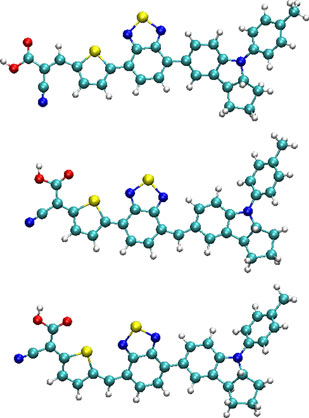Crossref Citations
This article has been cited by the following publications. This list is generated based on data provided by
Crossref.
Li, Huixing
and
Chen, Maodu
2013.
Structure-property relationships for three indoline dyes used in dye-sensitized solar cells: TDDFT study of visible absorption and photoinduced charge-transfer processes.
Journal of Molecular Modeling,
Vol. 19,
Issue. 12,
p.
5317.
Chan, Matthew
Carrington, Tucker
and
Manzhos, Sergei
2013.
Anharmonic vibrations of the carboxyl group in acetic acid on TiO2: implications for adsorption mode assignment in dye-sensitized solar cells.
Physical Chemistry Chemical Physics,
Vol. 15,
Issue. 25,
p.
10028.
Manzhos, Sergei
2013.
Effects of Nuclear Vibrations on the Energetics of Polythiophene: Quantized Energy Molecular Dynamics.
Australian Journal of Chemistry,
Vol. 66,
Issue. 9,
p.
1021.
Tu, Wei Han
Tan, Yi Yin
and
Manzhos, Sergei
2014.
Achieving Improved Solar Absorbance of Small Organic Dyes Featuring Quinoidized Five-Membered Heterocycles.
MRS Proceedings,
Vol. 1667,
Issue. ,
Tan, Yi Yin
Tu, Wei Han
and
Manzhos, Sergei
2014.
Computational design of small organic dyes with strong visible absorption by controlled quinoidization of the thiophene unit.
Chemical Physics Letters,
Vol. 593,
Issue. ,
p.
14.
Tu, Wei Han
Tan, Yi Yin
Rege, Omkar
and
Manzhos, Sergei
2015.
Computational design of small phenothiazine dyes for dye-sensitized solar cells by functionalizations affecting the thiophene unit.
Journal of Molecular Modeling,
Vol. 21,
Issue. 4,
Shen, Tianruo
Gao, Ying
Wang, Chao
Xu, Zhaochao
and
Liu, Xiaogang
2021.
Methine-Quinoidal Fragment Induces Significant Bathochromic Shifts in Organic Dyes.
The Journal of Physical Chemistry B,
Vol. 125,
Issue. 5,
p.
1447.





